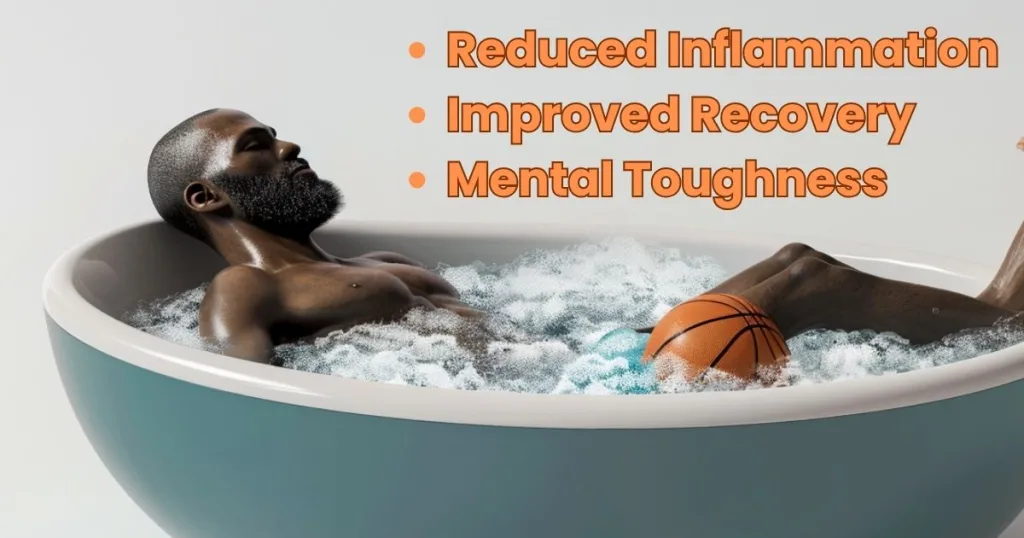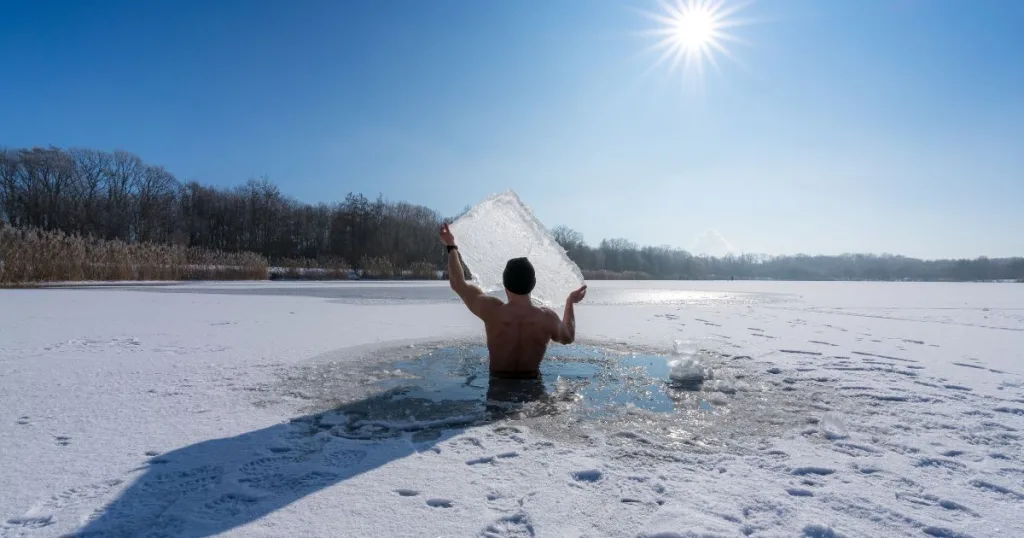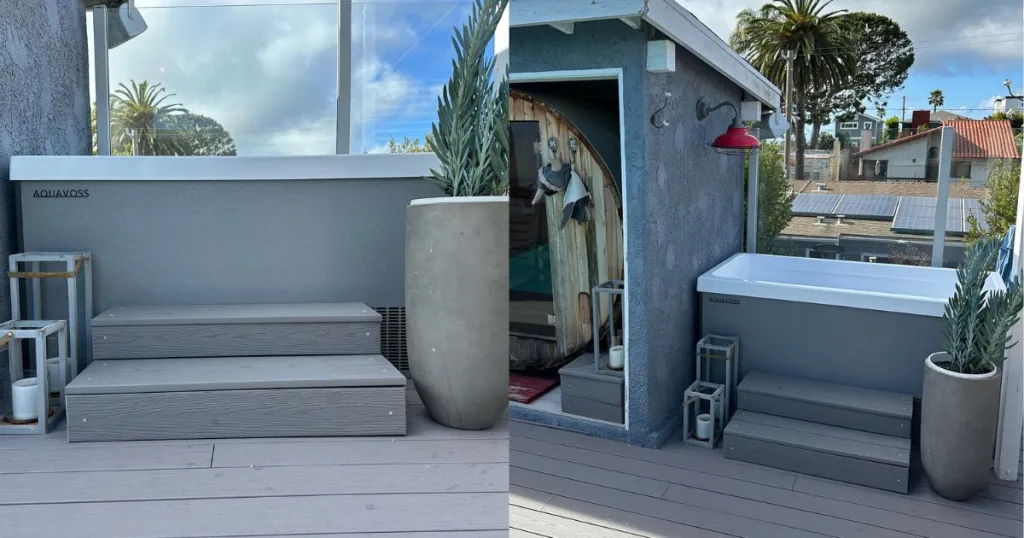Last Updated on: 2nd March 2024, 01:53 am

Did you know that basketball players often use ice baths for post-game recovery?
I’ve found that this intense, chilling routine can be a secret weapon in maintaining peak performance on the court.
The initial sting of the cold water gives way to a soothing relief as my muscles relax and fatigue washes away.
It’s a fascinating phenomenon.
The question remains: how does this icy immersion truly impact an athlete’s body and performance?
Let’s dive into this frosty topic together, shall we?
Potential Gains from Cold Plunges
As a basketball player, I’ve significantly benefited from incorporating cold plunges into my recovery routine.
The immediate reduction in inflammation and the enhanced muscle recovery have been game-changers for my performance.
The mental resilience I’ve gained from regularly facing the discomfort of the icy water seems to translate directly to my stamina and focus on the court.

Reduced Inflammation
In basketball, cold plunges are a powerful tool for reducing inflammation after a strenuous game, significantly aiding in faster recovery and readiness for the next match. They’re a secret weapon, lowering body temperature and thereby reducing muscle swelling, which can cause soreness.
This reduction in inflammation is a key factor in speeding up recovery time, allowing players to return to the game sooner.
These aren’t just for the pros; NBA players commonly utilize cold plunges post-game to maintain peak performance levels. By incorporating cold plunges into their routine, these athletes minimize discomfort while maximizing their potential on the court.
Improved Recovery
While it’s well-documented that cold plunges reduce inflammation, they’re also instrumental in improving post-exercise recovery, a vital aspect for any athlete striving for optimal performance.
It’s the cold water immersion that’s key here. By constricting blood vessels, it aids in muscle recovery, decreasing the dreaded delayed onset muscle soreness.
As an athlete, this means less downtime and more time honing skills on the court. Studies suggest this practice minimizes fatigue and lowers injury risk — a double win for performance. Cold plunges can also expedite the healing of soft tissue injuries and promote neural and cardiovascular recovery.
To say that cold plunges are refreshing would be an understatement; they’re a game-changer in sports recovery.
Mental Toughness Enhancement
Beyond the physical benefits, cold plunges offer a unique opportunity to enhance an athlete’s mental toughness. Enduring a cold plunge’s discomfort and challenging conditions helps build resilience over time.
It’s not just about cooling down muscles; it’s about sharpening the mind, improving focus, and fostering discipline. Regularly subjecting oneself to this stress can increase mental fortitude, enabling an athlete to perform under pressure.
The discipline honed by cold immersions translates directly to the basketball court, helping me overcome obstacles and adversity.
I’ve found that the more I engage in cold plunges, the stronger my mindset becomes.
It’s a powerful tool for mental toughness enhancement that goes hand in hand with physical recovery.
Potential Pains and Drawbacks
While there’s value in ice baths for basketball players, it’s equally important to consider the potential drawbacks.
The discomfort and pain from the extreme cold can be off-putting, and there are risks if the technique isn’t performed correctly.
Further, the scientific evidence supporting the benefits of ice baths is limited and conflicting.

Discomfort and Pain
Despite the numerous benefits, the icy embrace of the basketball ice bath often deters players due to the discomfort and potential pain caused by the extreme cold temperatures.
The ice bath discomfort can be challenging, with cold-induced pain varying among individuals. This discomfort and pain perception can influence athletes’ willingness to use this recovery strategy.
- The duration of the session can impact the discomfort experienced
- Individual tolerance to cold temperatures also plays a part
- The perception of pain can deter athletes from using ice baths
- Balancing benefits and discomfort is vital in recovery strategies
Improper Technique Risks
Though basketball ice baths can be beneficial, improper techniques can lead to significant risks, including frostbite, skin damage, and nerve injuries.
Diving into the cold water without preparation or staying in too long can shock the body, leading to discomfort and potential harm.
The risks escalate if the water temperature is incorrectly set, increasing the chance of hypothermia and other cold-related injuries. Also, prolonged exposure isn’t just uncomfortable; it could result in tissue damage or adverse skin reactions.
Without adequate supervision, athletes may endure unnecessary discomfort and negative physiological responses. To reap the benefits of ice baths and minimize risks, it’s crucial to learn and implement proper techniques.
Limited Scientific Evidence
There’s growing debate about the efficacy of basketball ice baths, with some research suggesting that the perceived benefits may be an active placebo effect.
As a dedicated hoopster, it’s crucial to scrutinize the evidence and understand the potential drawbacks of this popular muscle therapy.
- Some studies indicate that while ice baths may reduce pain temporarily, they could impede long-term recovery.
- Health journalist Christie Aschwanden has expressed concerns about potential harms, even if many athletes swear by their benefits.
- The belief that more pain equals more gain could be misleading us into thinking ice baths are more effective than they are.
- Overreliance on ice baths might detract from essential recovery components like proper nutrition, hydration, and sleep.
Balancing the mental benefits of ice baths with their potential risks is key to optimizing athletes’ performance.
How to Do Cold Plunges Right
Now, let’s talk about how to execute cold plunges correctly.
We’ll discuss the necessary equipment and guidelines and what you should do after a plunge to maximize its benefits.
We’ll also address the importance of an individualized approach since every athlete’s body responds differently to this recovery technique.
Essential Equipment and Guidelines
Getting the most out of your basketball ice bath involves having the right equipment and following specific guidelines for optimal recovery. Here’s what you’ll need:
- A tub or container large enough for body immersion
- Ice or cold water to reach the desired temperature
- A thermometer for accurate temperature monitoring
- A timer to control immersion times
The recommended water temperature for a cold plunge is between 50-59 degrees Fahrenheit. Your immersion times should vary between 10-20 minutes, depending on your experience level. Remember, consistency is key in maximizing recovery benefits from your ice bath.
And always re-warm gradually after a plunge, avoiding intense activity immediately to prevent thermal shock.
Recommended Cold Plunges
If you want to do cold plunging right, you need a good place to do it. My recommendation would be to check out Aquavoss.
Just look at these amazing cold plunge areas their customers have created for themselves – you need this, too!
Post-Plunge Recommendations
To optimize your post-plunge recovery, it’s crucial to incrementally increase your cold plunge sessions to roughly 3 minutes, allowing the numbing effects of the cold to take full effect.
The optimal time for recovery benefits is between 11 to 15 minutes per session. However, it’s essential not to rush this process, as each individual’s response to cold exposure can vary.
If you have preexisting health conditions, it’s imperative to seek medical advice before plunging into this routine to avoid potential risks.
If cold plunges seem too daunting, cold showers can be a viable alternative, offering similar benefits.
Individualized Approach
In tailoring an individualized approach to cold plunges, it’s vital to consider factors like water temperature, duration, and frequency that align with the player’s unique needs.
I recommend you:
- Consult with a sports science professional to optimize your cold plunge sessions.
- Monitor and adjust your cold plunge protocol based on your body’s responses.
- Gradually increase cold plunge intensity to acclimate your body over time.
- Customize your cold plunge strategy to your specific recovery goals and preferences.
Beyond the Plunge: Alternative Recovery Strategies
While ice baths have their place, it’s important to consider other recovery strategies as well. Compression therapy, a good night’s sleep, proper nutrition, and contrast showers are just a few alternatives that can complement our recovery regime.
Let’s examine these methods and understand how they can help us bounce back from intense basketball games or training sessions.
Compression Therapy
Beyond the chilling plunge of ice baths, athletes are turning to compression therapy as an effective alternative method for muscle recovery and performance enhancement.

This recovery strategy capitalizes on enhanced circulation and the reduction of muscle soreness. It’s not just about the squeeze but what the squeeze does:
- Encourages blood flow to flush out metabolic waste
- Reduces swelling and inflammation
- Speeds up recovery by enhancing the body’s natural healing processes
- Boosts oxygen and nutrient delivery to muscles for better performance
In essence, compression therapy is a game-changer. It helps athletes bounce back faster and maintain their peak physical condition. It may lack the icy shock of a traditional bath, but the benefits are clear and compelling.
Sleep and Nutrition
Moving from the external support of compression therapy, let’s focus on internal recovery strategies like sleep and nutrition, which are equally crucial for an athlete’s optimal performance and quick recovery.

Beyond the plunge into an ice bath, quality sleep is vital for muscle recovery, with athletes needing 7-9 hours nightly. It’s not just about the quantity but the quality of sleep that can make a significant difference.
Proper nutrition and hydration, too, play a pivotal role. A balanced meal replenishes glycogen stores, aiding recovery, while staying hydrated supports overall performance. Supplements, whether protein shakes or vitamins, can further optimize this recovery process.
Contrast Showers
Taking a step further from the icy plunge of post-game recovery, let’s explore the benefits of contrast showers as an effective alternative strategy athletes use to accelerate recovery and promote circulation.

Contrast showers are a blend of hot and cold therapy. They enhance muscle recovery by creating a pumping mechanism in the blood vessels and stimulating the nervous system.
Here’s how they work:
- Hot water expands blood vessels, promoting blood flow and flushing out toxins.
- A sudden switch to cold water constricts blood vessels, reducing swelling and inflammation.
- This alternation helps flush out lactic acid, a contributor to muscle soreness.
- Lastly, the process boosts energy levels, making you feel refreshed and rejuvenated.
Athletes, we’ve got more than just an ice bath for recovery. Embrace the heat too!


